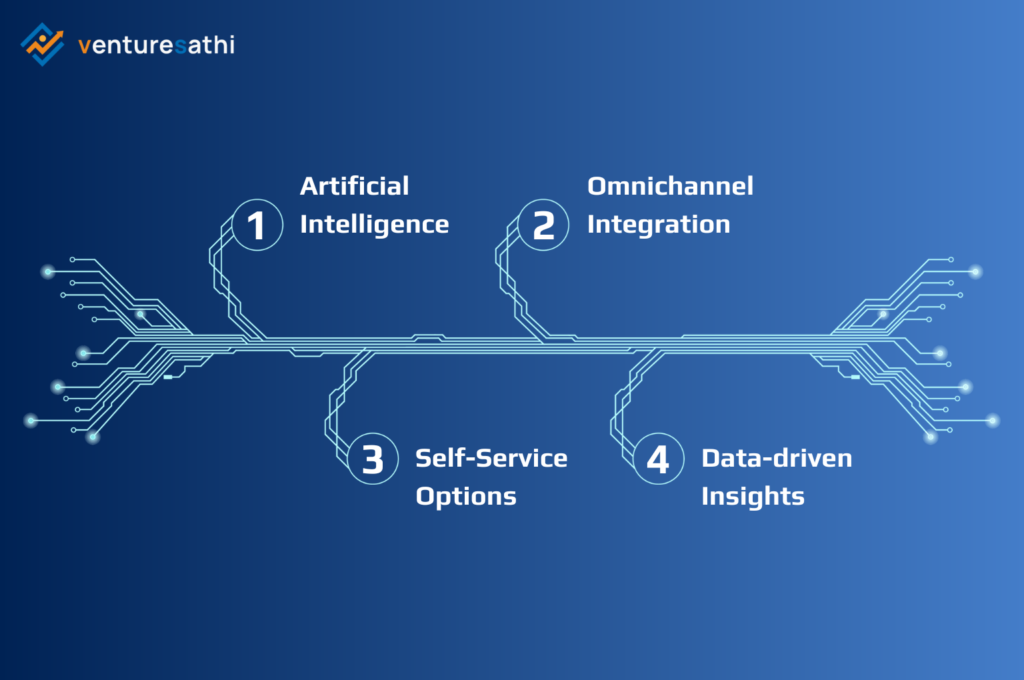5 Ways You Can Adapt to AI in Contact Centers
In 2025, contact centers are no longer just service hubs, they’re resolution engines. Customers don’t care about the channel they use or whether they interact with a human or a bot, they care about one thing: their issue being solved quickly and efficiently.
If you’ve been following the AI hype, it’s tempting to invest in flashy tools without a clear plan. But the data tells a different story: half of companies are delighting customers, and the other half are driving them away. The winners are those who orchestrate AI and human agents to eliminate friction, while the losers are trapped in slow, disconnected workflows.
If you’ve been following the AI hype, it’s tempting to invest in flashy tools without a clear plan. But the data tells a different story: half of companies are delighting customers, and the other half are driving them away. The winners are those who orchestrate AI and human agents to eliminate friction, while the losers are trapped in slow, disconnected workflows.
Why AI Isn’t Just Hype
According to Verint’s State of Customer Experience 2025 report, customers have never been more digitally engaged, with 73% preferring digital channels over traditional phone support. Even more striking, 86% of consumers now recognize the benefits of AI-powered customer service and among 18–34-year-olds, that figure jumps to 98%.
These numbers aren’t just statistics; they reveal a fundamental shift in customer psychology. Consumers are no longer loyal to brands that simply respond—they reward speed, efficiency, and resolution-first experiences. Over half of customers (56%) rank receiving information quickly as the most critical element of CX, while nearly as many (52%) value resolving issues without human interaction. Yet, 48% still want human support when necessary, highlighting the delicate balance between automation and empathetic service.
These numbers aren’t just statistics; they reveal a fundamental shift in customer psychology. Consumers are no longer loyal to brands that simply respond—they reward speed, efficiency, and resolution-first experiences. Over half of customers (56%) rank receiving information quickly as the most critical element of CX, while nearly as many (52%) value resolving issues without human interaction. Yet, 48% still want human support when necessary, highlighting the delicate balance between automation and empathetic service.
The Five Strategic Shifts That Matter
So the question becomes: How do we adapt?
Through my work, I’ve seen five big levers that separate companies that thrive in this shift from those that drown in it.
Through my work, I’ve seen five big levers that separate companies that thrive in this shift from those that drown in it.
Value Migration
Automate Transactions, Protect Trust
AI makes routine interactions cheaper, faster, almost invisible. But not every interaction should be automated. Some moments — complaints, renewals, high-value cases — are trust moments. These must remain human, supported by AI. Because customers don’t remember the bot that processed their refund; they remember the human who fought for their loyalty.
The Digital Twin of the Customer
The real power of AI isn’t automation, it’s anticipation. Imagine a real-time model of each customer: their mood, their history, their likelihood to churn. Now you’re not just answering calls, you’re predicting them. You’re not reacting, you’re orchestrating. That’s what I call the Digital Twin.
Agents Become Ambassadors
Here’s a truth we don’t talk about enough: AI liberates agents. It strips away the drudgery and leaves space for what humans excel at empathy, persuasion, storytelling.
When companies reframe agents as brand ambassadors not cost centers something magical happens. Employees feel proud. Customers feel heard. And suddenly, the contact center is not a place of attrition, but of loyalty creation.
When companies reframe agents as brand ambassadors not cost centers something magical happens. Employees feel proud. Customers feel heard. And suddenly, the contact center is not a place of attrition, but of loyalty creation.
Invisible Support
The best support experience? The one you never needed.
AI gives us x-ray vision into why customers contact us. Smart leaders don’t just patch symptoms; they fix root causes — broken forms, unclear policies, buggy UX. Month by month, they make the contact center disappear. And customers? They love it.
AI gives us x-ray vision into why customers contact us. Smart leaders don’t just patch symptoms; they fix root causes — broken forms, unclear policies, buggy UX. Month by month, they make the contact center disappear. And customers? They love it.
Narrative Control
And finally, let’s be honest: AI makes people nervous. Employees fear replacement.
Customers worry about cold automation. That’s why leaders must own the story.
The winning narrative isn’t “AI is cheaper.” It’s “AI gives us superpowers.” Show your agents how it makes their job easier, their bonuses bigger, their work more meaningful. Tell customers it means faster resolutions and more personalised care. Storytelling, not technology, is what wins adoption.
Customers worry about cold automation. That’s why leaders must own the story.
The winning narrative isn’t “AI is cheaper.” It’s “AI gives us superpowers.” Show your agents how it makes their job easier, their bonuses bigger, their work more meaningful. Tell customers it means faster resolutions and more personalised care. Storytelling, not technology, is what wins adoption.
Closing Thought
The contact center of the future won’t be measured by average handle time. It will be measured by average trust built per minute.
And AI, if we use it wisely, is the greatest trust accelerator we’ve ever had.
Here’s the takeaway: AI is not just a cost-cutting tool. It’s a value-migrating engine. It doesn’t just change workflows. It changes trust.
And AI, if we use it wisely, is the greatest trust accelerator we’ve ever had.
Here’s the takeaway: AI is not just a cost-cutting tool. It’s a value-migrating engine. It doesn’t just change workflows. It changes trust.


